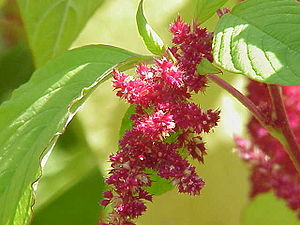Cookbook:Amaranth
| Amaranth | |
|---|---|
  |
Cookbook | Recipes | Ingredients | Equipment | Techniques | Cookbook Disambiguation Pages | Ingredients | Vegetable
Amaranth or pigweed are a variety of plants in the genus Amaranthus. Although several species are often considered weeds, people around the world use amaranth in cooking as a leaf vegetable or cereal grain. It is easily harvested, produces many seeds, and is tolerant of arid environments.
The leaves may go by the names bayam (Indonesia/Malaysia), kulitis (Philippines), callaloo (Caribbean), mchicha (Swahili), efo tete (Yoruba), arowo jeja (lit. "we have money left over for fish"), African spinach, rau dền (Vietnam), or enga lenga/biteku teku (Congo).
Characteristics
editAmaranth seeds are very small, just a little bigger than poppy seeds.[1] They are yellow to pinkish, and they have a nutty flavor.[2]
Use
editAmaranth seeds are starchy and treated as a culinary grain.[3] They are cooked much like other cereals by simmering in water.[1] From there, it can be incorporated into other preparations like soups and salads. It can also be toasted in a dry skillet like popcorn[1]—when mixed with honey or molasses, this makes a treat called alegría (literally "joy" in Spanish).
In the Caribbean, amaranth leaves are sometimes used in pepperpot soup. It is a common vegetable in West Africa, frequently eaten in soups or along with cooked starches. In Andhra Pradesh, India, the leaf is added to a popular dal called thotakura pappu. In China, the leaves and stems are used as a stir-fry vegetable and called yin choi (苋菜; pinyin: xiàncài). In Vietnam, it is used to make soup.
Nutrition
editAmaranth seeds contain exceptionally complete protein when compared to other cereal grains.[2] It is also a good source of dietary fiber and minerals such as iron, magnesium, phosphorus, copper, and manganese.
Recipes
editReferences
edit- ↑ a b c "Learn All About Amaranth, a Gluten-Free Grain". The Spruce Eats. Retrieved 2023-12-01.
- ↑ a b Gisslen, Wayne (2015-03-12). Essentials of Professional Cooking, 2nd Edition. Wiley Global Education. ISBN 978-1-119-03072-0.
- ↑ Figoni, Paula I. (2010-11-09). How Baking Works: Exploring the Fundamentals of Baking Science. John Wiley & Sons. ISBN 978-0-470-39267-6.